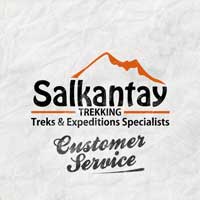Rainbow Mountain — Ultimate Packing List
If you’re coming to Cusco, Peru, soon and planning your trip, we’re sure you’ve added a trek to Rainbow Mountain to your ideal itinerary.
This is one of the most exciting day trips out of the city and is the perfect chance to see a once-in-a-lifetime view and landscape.
There’s no doubt you’re getting anxious to leave and set foot in the beautiful Andes. But with all the different excursions you likely have organized, you might be wondering what you need to take on them all.
After all, there are so many microclimates in Peru that you’ll need completely different gear to visit Machu Picchu than you do for visiting Rainbow Mountain.
Don’t worry. We’ve got you covered and put together the ultimate packing list for a day trip to Rainbow Mountain. We’ve also put in some recommendations of top equipment that we always use and love. We want your trek to be as comfortable as possible so you can enjoy it to the max.
Let’s get into the details.
If you’re coming to Cusco, Peru, soon and planning your trip, we’re sure you’ve added a trek to Rainbow Mountain to your ideal itinerary.
There’s no doubt you’re getting anxious to leave and set foot in the beautiful Andes. But with all the different excursions you likely have organized, you might be wondering what you need to take on them all.
Don’t worry. We’ve got you covered and put together the ultimate packing list for a day trip to Rainbow Mountain. We’ve also put in some recommendations of top equipment that we always use and love. We want your trek to be as comfortable as possible so you can enjoy it to the max.
Let’s get into the details.
The Essential Packing List for Trekking the Rainbow Mountain
Documents
Original Passport
You’ll have your passport with you as you need it to get into the country. You also need it for a lot of places you’ll be visiting, including Rainbow Mountain. Some places won’t let you in without it and it’s always important to have it with you in case of an emergency.
Backpack
Backpack
The Rainbow Mountain Trek is only a day trip, so you don’t need to take a huge rucksack or one of our duffle bags. You’ll only have to take a lightweight backpack to carry the essentials you’ll need along the route, like snacks, water, camera, sunscreen, etc.
We suggest a backpack with compression straps to reduce pressure on your back, and side mesh pockets for swift access to your water bottle. The Osprey Talon is our top backpack.
It’s important you bring a rain cover for your backpack because you never know when there’ll be a shower in the Andes. If you decide to use an Osprey backpack, then make sure you get an Osprey Raincover that matches the bag size for a tight fit.
Clothing
Underwear
The most important layer is your underwear. You need a comfortable pair to help you when hiking. One that’s breathable is a must.
Our favorites are Icebreaker underwear, Adidas sports underwear, or Under Armour underwear, as these labels specifically focus on manufacturing goods that can cope with sweat from high-intensity exercise and sports.
Base Layer
This layer is sometimes known as the next-to-skin or first layer. It’s a very important piece of clothing as Rainbow Mountain is very cold when you’re standing at the top for a while. This fits snugly to your skin and keeps you warm by reducing air pockets and flow and consists of high wicking materials to facilitate moisture transfer.
Trekking Shirts
On top of your base layer, we suggest you use a trekking shirt. We applaud these breathable and lightweight shirts from Hanes. Alternatively, models from Icebreaker or Columbia are also of great quality.
Don’t bring cotton shirts as these soak up moisture and can lead to you feeling very uncomfortable.
Hard Shell Jacket and Rain Gear
Rain is always a likelihood when hiking in Peru, especially during the rainy season (October-March). You should take a hard-shell jacket for extra protection when it’s wet, like the North Face Resolve Jacket.
It’s also a good idea to take a compact rain poncho that can quickly be put on should you encounter a light shower.
Insulated Jacket
This is your outer later and should be wind and waterproof. It also needs to keep you warm on the upper part of the trek.
We strongly recommend buying a high-quality jacket as it’s one of the few essential items that’ll ensure your warmth and comfort along the route. We suggest the North Face Nuptse Jacket— which is a market-leading winter jacket—but there are several synthetic options that are also practical.
In terms of the Nuptse, the warmth and weight properties are outstanding. The Nuptse is a lifetime investment as the jacket will last years of intense trekking and duplicate well as a winter jacket in the city. Other top jacket brands include Patagonia Down Jacket, Arc’Teryx Atom, and Mountain Hardwear Down Jackets.
Fleece Jacket
For extra warmth, we recommend a fleece as your second layer.
We really like the Polartec 200 Fleece Jacket. These insulation jackets are remarkably good for hiking as they give great warmth to weight ratio whilst providing effective moisture transfer.
Suggested fleece brands included Helly Hansen, The North Face, and Patagonia.
Trekking Pants
For ultra comfort on the Rainbow Mountain Trek, we suggest you wear trekking pants. They’re lightweight and provide great protection from the wind. There are numerous brands to choose from, but we recommend Craghoppers, Columbia, or O’Neills.
Gloves
Gloves act as a buffer from the cold and have to be very warm, waterproof, and durable. Gore-Tex gloves from Dakine or similar options from The North Face, Outdoor Research, or Black Diamond are recommended.
Headgear
Hat for Sun Protection
You need to take a hiking hat that provides face and neck protection from the glaring sun. At high altitudes (over 5,000 masl on the Rainbow Mountain route), it’s easy to get sunburnt in just a few minutes.
Your hat should be light and simple to bend/fold so that it can fit into your backpack easily. Trekking hats with a neck cover are fantastic to give you ultimate protection.
Headband or Beanie
As previously mentioned, the temperature can get very cold at the top of the mountain. You’ll also be leaving bright and early when the climate is still very cool.
A warm fleece beanie or fleece headband are undeniable must-haves. Berghaus and The North Face provide some fabulous beanies that are perfect for trekking in the cold.
Neck Gaiter or Balaclava
If you feel the cold a lot, we recommend a buff to keep your neck warm. Buffs are very versatile and can be used as headbands, beanies, neck gaiters, and wristbands, as demonstrated in the image.
Footwear
Hiking Boots
Possibly the most important item on the trek is your hiking boots. They’re what get you to the top of the mountain, after all.
Badly fitting hiking boots will result in damaged toenails, sore blisters, and all-around painful feet.
To find the best fit, put your foot in a boot without tying the shoelaces. Once in, slide your foot all the way forward until the toes hit the front of the boot. You should be able to put your index finger down the back of the boot between your heel. If your finger has lots of room to move then the shoe is too big, but if you struggle to get your index finger into the boot then the shoe is too small.
Here are some recommended and reliable brands of the best hiking boots: Scarpa, Salomon—we like the Quest range—, Berghaus—we like the Explorer range—, Hi-Tec, and Karrimor.
Hiking Socks
You can use regular socks, but hiking socks like Coolmax hiking socks provide excellent breathability and have fantastic wicking properties. Smartwool, Bridgedale, and Point 6 also make great socks.
Gaiters
Gaiters are made from waterproof material and reach up from your boot to the top of your calf.
Gaiters are used to stop water, dust, mud, snow, ice, and small stones from getting into your hiking boots. These are great for this day trip, especially during the rainy season.
Important Accessories
Trekking Poles
The route to Rainbow Mountain is relatively challenging, and quality walking poles can significantly reduce the impact on your knees and leg joints—up to 20 percent. Trekking poles are particularly useful when descending, as the pressure on your joints increases a great deal when going downhill.
We recommend getting light-weight (around 350 grams per pair) and adjustable trekking poles, as they’re easy to store and very adaptable. Black Diamond walking poles are great, as are Leki poles.
Sunglasses
Going over 5,000 masl means you’re going to be very close to the sun's UV rays, which can damage your eyes. You should bring a quality pair of UV protection sunglasses (minimum of 80% light reduction). We promote mountain sunglasses from Julbo.
Water Bottle or Hydration Bladder
Dehydration is common at high altitude. You need to drink at least 2 liters of water a day.
Water can be carried in a standard water bottle—we recommend getting 2 x 1L CamelBak Water Bottles.
Or, if your daypack includes space for a hydration bladder, then the 2L Platypus Hydration Bladder is an excellent product.
Camera
Rainbow Mountain is one of the most incredible landscapes known to man. You’ll most likely want to capture your experience in HD, so if you don’t have a nice camera, now’s the time to get one.
Here are some recommended and affordable Digital SLR cameras. Remember, you want to make sure your camera is light but still able to capture high-quality images. We like the Panasonic Lumex. If you’re more inclined to take videos, then you might want to consider the GoPro.
Personal Gear and Medication
-
Cash
Along the route, there are spots to buy snacks and water. It’s also a great idea to have extra cash (S/100–S/200) in case of an emergency.
-
Toilet Paper
You might need to go to the bathroom during the day. You’ll need toilet paper as most toilets don’t usually provide this.
-
General Medications
We recommend taking paracetamol or aspirin for headaches (a common altitude sickness symptom on the Rainbow Mountain Trek).
-
Basic First Aid Kit
If you’re joining an organized trek, your guide will most likely be carrying a first aid kit. If you’re hiking unsupported or independently then a first aid kit is a must.
-
Sunscreen/Lip balm
No one wants burnt skin or cracked lips. Be sure to bring 1 x sunscreen (SPF 50+) and 1 x lip balm.
-
Blister Plasters
The dreaded blisters! We recommend taking Compeed blister plasters
-
Hand Sanitizer
Great for disinfecting hands before and after eating, or when they get dirty during the hike.
Find the Perfect Destination in Peru
With astonishingly varied landscapes, stunning scenery, compelling history, and a legacy of fascinating cultures, there is truly something for everyone. Our expeditions in Peru are designed to showcase all that this country has to offer.
Our expeditions in Peru are designed to showcase all that this country has to offer.











